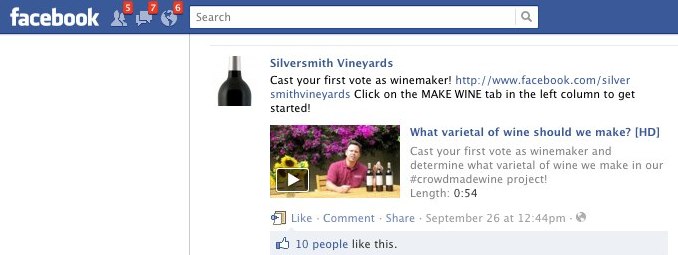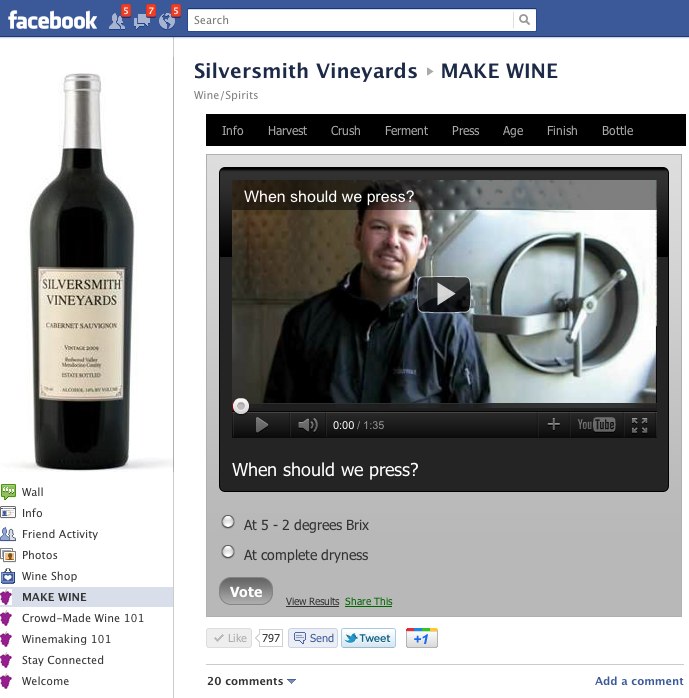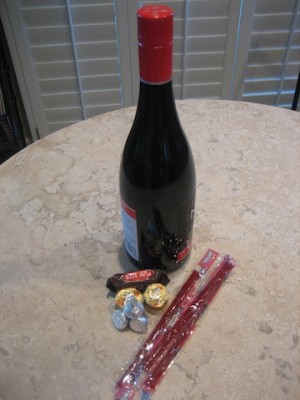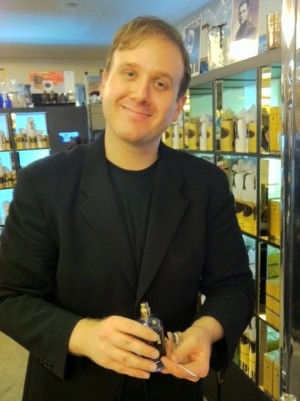 “Harvest is complete!!! Our Cabernet Sauvignon has been picked and crushed, and the yeast strain and fermentation tannins YOU selected have been added.” This was the declaration posted Thursday morning, November 3, on the Silversmith Vineyards Facebook page. “They did not pick the yeast that I normally use,” winemaker Tom Johnson says. “It’s a new experience for me.”
“Harvest is complete!!! Our Cabernet Sauvignon has been picked and crushed, and the yeast strain and fermentation tannins YOU selected have been added.” This was the declaration posted Thursday morning, November 3, on the Silversmith Vineyards Facebook page. “They did not pick the yeast that I normally use,” winemaker Tom Johnson says. “It’s a new experience for me.”
The “they” refers to Silversmith’s Facebook fans, 797 of them, who are voting on winemaking decisions for the 2011 vintage. “I thought Matt was crazy when he came up with this idea,” says Tom. “I thought no one would be interested and no one would participate. Boy was I wrong.”
Matt Johnson is Tom’s son and sales and marketing director for Silversmith Vineyards. His idea: crowd-source all the decisions in the winemaking process to the winery’s Facebook fans who “like” the winery’s page. They’re calling it the Crowd-Made Wine Project. Other wineries have used crowd sourcing for things like naming a wine or choosing a label design, but not to decide on things like which strain of yeast or how far apart the rollers are on the grape crusher. “We wanted to remove all the barriers and pull back the curtain on winemaking, to make it accessible and open the door to as many decisions as possible,” Matt says.
Silversmith is a small family owned winery (producing about 1200 cases), located in Mendocino County’s Redwood Valley in northern California. They grow and make estate Cabernet Sauvignon, Zinfandel and Petite Sirah. The first decision was which of these three varietals would be the crowd sourced wine. Votes came in from seven countries on four continents. “The crowd chose Cabernet,” says Tom, although he hoped it would be Petite Sirah.
This is the first time I’ve heard of a winery inviting outside participation in crafting a wine. Until now Tom viewed winemaking as a solitary affair. It was a little tough for him to let go and have decisions made for him by people he doesn’t know. Tom and Matt are brave men.
Tom’s not too worried that the crowd will steer him wrong. “This process forces us to re-examine all of our winemaking decisions. Since we are explaining each step of the process through social media, it’s like a refresher course in winemaking for us.” For each decision to be made, Matt makes a short video about the choices. He and Tom direct, shoot and edit these, including this one explaining the crowd-made wine process. I see it as a great educational platform. At other wineries I’ve helped pick and sort grapes during harvest, but I certainly wasn’t aware of all the decisions that have to be made even before the grapes make it into the crusher. I am enjoying learning about the process. I sense that Silversmith’s Facebook fans do too.
One decision that did not follow the Facebook vote was when to pick the grapes. Brix is a measurement of the sugar level in grapes, and it’s an indicator of ripeness. The crowd vote was tied – to pick at 23 and 24 degrees brix. Because the 2011 growing season has been cooler than normal, the grapes are taking longer to fully ripen. But this week mother nature stepped in and with rain on the horizon the Johnsons couldn’t wait to pick at 23 or 24 brix. They harvested at 22.5 brix, but they got the grapes in before the rain, which could have left mold or other problems in its wake.
The lower sugar means other choices in winemaking, says Matt. “We see this as an opportunity for another potential decision down the road about our post fermentation options. “That could include adding grape juice concentrate to get a higher sugar level or making the wine at a lower alcohol level. Tom says, “we’ve opened the secret Houdini basket and we’re letting out all the secrets.” Brave indeed.
“We had 150 to 200 Facebook fans when we started this,” says Matt. Now it’s closer to 800 fans. “We didn’t have Twitter at all.” Now Silversmith has 442 followers. The Johnsons see social media as a way to connect with people by getting them involved in the process. The goal is to bring more people to wine and help them feel more informed about it instead of being intimidated by it. “We can tell through the comments we get that some people have lots of winemaking experience, but for some it’s clear this is their first rodeo,” Tom says. And that’s OK.
The decisions don’t stop at the end of harvest. “This is just the beginning of the process.” The first post-harvest decision is already on their Facebook page: when to press the wine off the must (the fermenting mixture of grape juice, skins and seeds from the grape crusher). I’m voting for complete dryness, when all the sugar has been converted to alcohol.
Up next, what pressure to use to press off the wine, when to rack wine and type of barrels for aging. This is a long term project that will go all the way through label design, what type of cork and capsule to use and how long to bottle age before releasing the wine for sale. That date will be a crowd decision, which could be anywhere from a year to two years from now. Will the Facebook crowd be dedicated enough to stay engaged for that long? It’s all part of the experiment of this crowd-made wine.
There’s plenty of time to join in. You don’t have to pay a thing to take part, you just need to “like” Silversmith’s Facebook page. The hope is the crowd will want to buy this wine. “We will open up and pre-sell first to our Facebook participants,” says Matt. It will be interesting to see if the wine sells out before it is released.
This may be the best use of social media in the wine world. Tom and Matt do their own Facebook posts and tweets. It’s just the two of them taking on this crowd-sourced wine project. It doesn’t get any more authentic or real than that.





1 Comment
Pingback: Wine Made Via Facebook Takes Crowd Sourcing To A Whole New Level